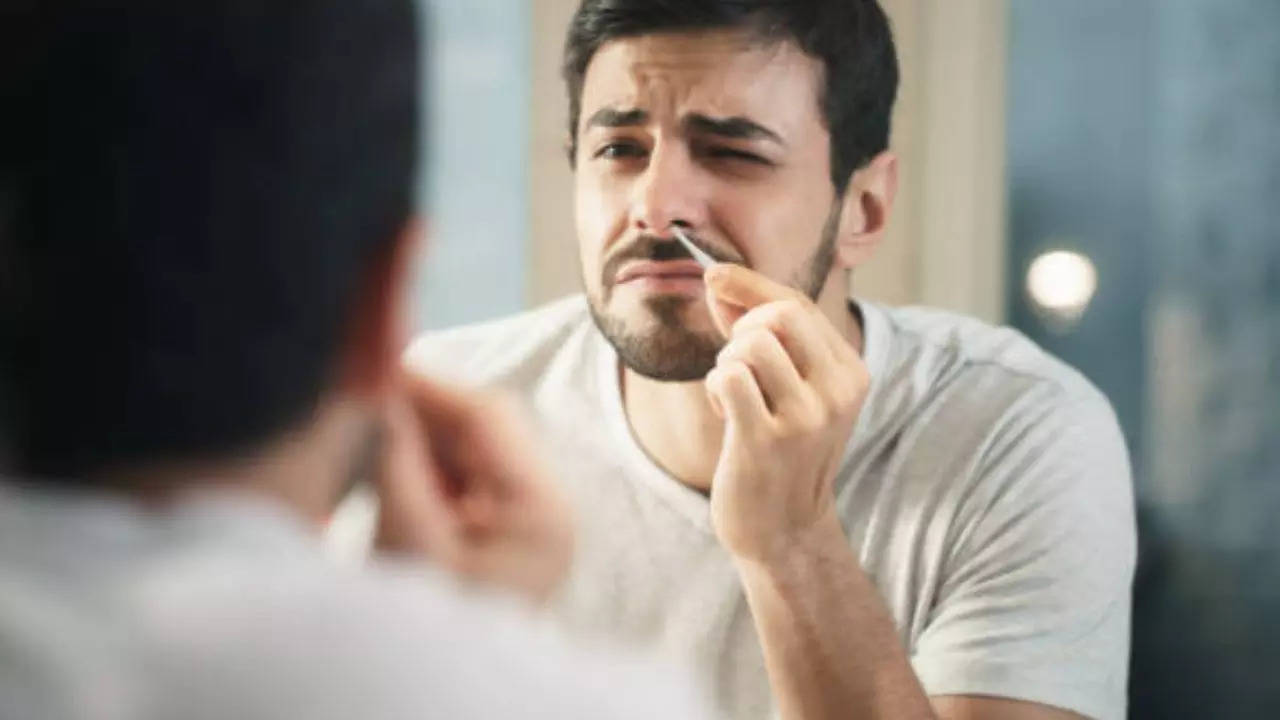-
news
-
Health
Are you removing nose hair safely? Know the risks before tweezing
Nose hair may seem like a nuisance to groom, but it plays an important role in respiratory health. Improper removal methods such as tweezing can lead to infection, ingrown hairs, and breathing problems. Read on to know safer alternatives like trimming or professional waxing to maintain both hygiene and health without compromising your safety.

Are you removing nose hair safely? Know before you take the risk (Image credit: iStock)
Let’s be honest – most of us have looked in the mirror and felt the urge to grab tweezers for a nose hair peeking out. But before rooting them out, have you ever stopped to think about why they exist in the first place? Believe it or not, those little hairs are more than just a cosmetic nuisance — they’re actually your nose’s first line of defense.
Nose hair, often considered unattractive by many, plays an essential role in our respiratory health. These tiny threads act as the first line of defense against pollutants, allergens and pathogens. Although the desire to look well-groomed is natural, improper nose hair removal can pose significant health risks. Here’s what you need to know before reaching for the tweezers.
role of nose hair
Nose hair plays an important role in maintaining respiratory health. It traps dust, dirt and other particles, preventing them from entering the lungs. Additionally, it helps to humidify the air we breathe, ensuring that the delicate tissues in the respiratory system remain moist and functional.
“Nose hair is like a natural filter. Removing too much of it impairs the nose’s ability to protect the lungs from harmful particles and infections,” explains Dr. Richard Harvey, a leading otolaryngologist at Macquarie University in Australia.
Risks of plucking nose hair with tweezers
Although removing nose hair may seem like a quick fix for grooming, it comes with a number of risks that should not be ignored.
1. Risk of infection
The nasal cavity is a sensitive area filled with tiny blood vessels. Plucking nose hairs can cause small wounds or open hair follicles, making the area vulnerable to bacterial infection.
Research published in The Journal of Clinical Medicine indicates that Staphylococcus aureus, a bacteria commonly found in the nasal passages, can enter the bloodstream through these small wounds, causing conditions such as cellulitis or abscesses. Is.
fact: The “danger triangle” of the face, which includes the nose, is particularly vulnerable because infection in this area can spread to the brain through interconnected nerves.
2. Ingrown hair
Plucking can cause nose hairs to grow back into the skin, causing painful ingrown hairs. These can cause swelling, redness, and even pus-filled blisters.
3. Difficulty breathing
Removing nose hair too enthusiastically can obstruct airflow, leading to dryness and irritation inside the nasal cavity. This may cause discomfort and increase the risk of respiratory infections.
Safe alternatives to tweezing
Luckily, there are safe ways to manage nose hair without putting yourself at unnecessary risk.
1. Trimming with an electric trimmer
Special nose hair trimmer designed to safely trim nose hair without pulling. These devices are easy to use and reduce the risk of injury or infection.
2. Nose Hair Scissors
Round-tip scissors made specifically for trimming nose hair are a manual and safe option. They allow you to control the length while avoiding the sensitive skin inside the nose.
3. Waxing (with caution)
Nose waxing kits are available, but they should be used sparingly and only on the outer hairs. This method removes the hair at the root but avoids the deeper, more sensitive parts of the nasal cavity.
Dr. Kimberly Bird, a dermatologist in New York, advises, “If you choose to wax, make sure it’s done professionally and only the outer hairs are removed. Never attempt deep waxing, as this increases the risk of infection and damage.
what to avoid
– Tweezers: Although they provide precision, tweezers have a higher risk of injury, infection, and ingrown hairs.
– Depilatory creams: These contain chemicals that can irritate the sensitive skin inside the nose and are not recommended nose hair removal,
– Shaving: Using a razor inside the nose can cause cuts, which can lead to infection or wounds.
when to see a doctor
If you experience any unusual symptoms after nose hair removal, such as redness, swelling, pain or pus, it is essential to seek medical attention immediately. These signs may indicate an infection that requires treatment.
Dr. Matthew Chambers, an ENT specialist in Los Angeles, warns, “Ignoring symptoms such as persistent pain or swelling can lead to serious complications. Early intervention is important to prevent serious consequences.”
Get the latest news live on Times Now with breaking news and top headlines from around the world.


